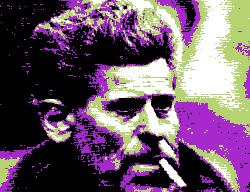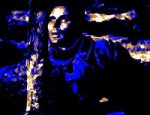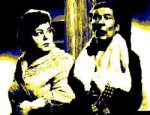Biography: life and films

A poet of the fantastic
Georges Franju may have been a contemporary of the French New Wave but he stands well apart from this diffuse ensemble of rule-breaking young Turks intent on revolutionising cinema at the time it most needed an infusion of new blood. Realistic portrayals of the mundanities of modern life à la Truffaut et alii were never part of Franju's filmmaking remit. Whilst present day concerns did figure prominently in much of his oeuvre - most notably the destructive impact of technological and industrial advancement on society and the natural world - his perspective was essentially always that of the humanist poet, not the objective social realist.Franju's body of work is modest, comprising eight cinematic features, a dozen or so shorts and a few pieces for television, but it represents an important contribution to the art of the moving image, characterised by an unsettling dreamlike aesthetic that has served to influence and inspire generations of filmmakers since. The director is best known for his deranged excursions into fantasy - in particular his early masterpiece Les Yeux sans visage (Eyes Without a Face), widely considered a landmark in the European horror film. These allowed him to perfect a coolly oneiric style that owes as much to the German expressionist films of the 1920s as it does to the French surrealist novel.
The stylistic influences of F.W. Murnau, Fritz Lang and André Breton can all be felt in many of Franju's films, along with the recurring allusions to the famous Louis Feuillade serials which gave commercial cinema some of its most iconic images in the first decade of its existence. Like his New Wave contemporaries, Franju was not afraid of referencing the cinematic triumphs of the past, and whilst doing so he succeeded in creating a form of film art that is entirely his own - personal, humane, weird and inexpressibly seductive.
Birth of a rampant cinéphile
Georges Franju was born in the Breton town of Fougères, Ille-et-Vilaine, on 12th April 1912. He had a twin brother Jacques and nurtured an eclectic reading habit from an early age, devouring the Fantômas stories of Pierre Souvestre and Marcel Allain as keenly as the literary classics. After an undistinguished school career he dabbled with various professions (for a time he was an insurance clerk and worked in a factory that manufactured noodles) before discovering an outlet for his artistic talents as a set designer for the musical hall and theatre.After completing his military service in 1932 Franju worked for a printing company, and this is how he came to meet Henri Langlois, who would have a decisive impact on his future career. Both men had a keen interest in cinema and in 1934 they made a documentary short together, Le Métro (1934). Langlois and Franju acquired the prints of a number of silent films and in 1936 they set up a film club named Le Cercle du cinéma, with money provided by Langlois's parents.
This is the point at which the two men became intensely preoccupied with the idea of film preservation, and to that end they created (with Jean Mitry) the Cinémathèque Française on 9th September 1936. Since, this institution has grown to become one of the world's leading film archives, devoted to the preservation and restoration of important works of film art. In 1938, Franju became the executive secretary of FIAF (Fédération Internationale des archives du film) and, eight years later, he founded the Académie du cinéma to further promote cinema around the world.
A provocateur in shorts
Franju returned to filmmaking in 1948, beginning with a series of short films which included several commissions from the French government. Through this early work, he was able to express his revulsion for the process of industrialisation that was transforming the modern world. This he saw as an ineluctable corruption of the landscape and human soul brought about by the march of progress under the forces of technology and capitalism. Instead of opting for a conventional realist approach, Franju created his own coolly ironic poetic style informed by his appreciation of French surrealism. His films can often be interpreted as subtle parables on the human condition, whose deeper meaning only become apparent after repeated viewings.The unsettling lyrical form that Franju employed on his early films often jarred with their subject matter and had the effect of making the content even more shockingly horrific. Nowhere is this more apparent than on his first notable work, Le Sang des bêtes (1949), a short documentary depicting the grisly routine of a typical Parisian abattoir. By juxtaposing gruesome images of animal dismemberment and scenes of everyday life outside the slaughterhouse Franju delivers a powerful statement on how society is in danger of becoming totally inured to violence and cruelty.
Le Sang des bêtes was the opening salvo in a loose trilogy of films which Franju dubbed his 'slaughter films'. It was followed by two government commissions which both ended up very differently to what was required. En Passant par la Lorraine (1950) was intended to promote the modernisation of industry in present day France, but what Franju delivered was the grimmest indictment of the environmental impact of industrialisation, the unsightly devastation caused by modern factories in pursuit of profit. Hotel des Invalides (1952) likewise was meant to be a serious tribute to the famous war museum, but its author uses it as a platform on which to proffer his deeply held anti-militarist views. Provocative as these early films were, they won Franju the prix Louis Lumière in 1954.
On the eve of the arrival of the French New Wave, Franju made a short film entitled La Première nuit (1958) which eerily presages Truffaut's Les 400 coups (1959). In this beguiling work, a solitary child wanders around Paris and discovers a fantasy world where his imagination can run riot. The nocturnal sequences in the deserted Paris metro are some of the most enchanting and lyrical of any French film and reveal a filmmaker of extraordinary poetic power.
Derangement and fantasy
With La Tête contre les murs (1959), Georges Franju went on to make a promising feature debut. Originally, the film was to have been directed by Jean-Pierre Mocky, who both scripted it (adapting a novel by Hervé Bazin) and took a leading role, so Franju had far less artistic freedom than he enjoyed on all of his subsequent projects. Despite this, the director managed to craft a compelling and powerfully moving indictment of mental health 'treatment' in contemporary France, a system by which the mentally ill are treated as convicted criminals, locked up in secure institutions more for the benefit of society than that of the afflicted. The film - which featured Charles Aznavour in his first substantial screen role - proved to be a hit with both critics and audiences, and allowed its director to make his presence felt just as the Nouvelle Vague came crashing onto the scene.With one success under his belt, Franju went on to make the film for which he is best known, his first excursion into the realm of fantasy. Strongly influenced by the silent classics Nosferatu and Dr Caligari's Cabinet, Les Yeux sans visage (1960) is cinema's most hauntingly lyrical excursion into visceral horror and whilst its shock value cannot be understated it stands as a work of extraordinary poetic beauty. Franju brings a beguiling fairytale quality to this gruesome tale of a mad surgeon (Pierre Brasseur) stealing faces from innocent young woman to repair his disfigured daughter (Edith Scob), and the film proved to be highly influential in the development of the horror film, in particular the medical and slasher sub-genres.
The public reaction to Les Yeux sans visage - which ranged from outrage to outright praise - could not help to raise Franju's profile, but this run of good fortune ended suddenly with his next feature, Pleins feux sur l'assassin (1961). Despite the pedigree of its authors Pierre Boileau and Thomas Narcejac (whose contorted thrillers had resulted in such memorable screen adaptations as Clouzot's Les Diaboliques and Hitchcock's Vertigo), this fairly routine murder mystery met with a lukewarm reception from the critics and audiences shunned it. Despite the careful artistry of the mise-en-scène and some incredibly atmospheric expressionistic photography, this third feature lacked the inspired touch of Franju's previous work and pretty well relegated him to obscurity for the remainder of his career.
With the assistance of Philippe Noiret and Emmanuelle Riva, two emerging talents of the period, Franju was able to craft what is undeniably his most grown-up film, an extraordinarily faithful adaptation of François Mauriac's great novel Thérèse Desqueyroux. Scripted and directed with sublime subtlety, the film conveys, more powerfully than any other cinematic work of this era, the crushing sense of confinement felt by an ordinary young woman trapped by bourgeois convention in a loveless marriage. Franju followed this captivating slice-of-life with another fantasy offering that could not be more different - Judex (1963). A full-on homage to the silent serials Fantômas (1914) and Judex (1916) directed by the director's hero Louis Feuillade, this is a surreal tour de force showing Franju at his most gloriously flamboyant.
What is reality?
For his next two films, Franju came back down to earth, with sensitively drawn portraits of two vulnerable individuals reacting against an unjust world governed by absurd precepts that exist merely to crush the individual. Thomas l'imposteur (1965) was a collaborative venture with Jean Cocteau (his last work for the cinema), who adapted his 1923 novel and worked surprisingly well with the director to create an anti-war film of remarkable power and lucidity.The dreamy unreality of Franju's distinctive poetry serves Cocteau's humanist narrative well, reinforcing the bold contrast that exists between the protagonist's naive view of war and the terrible reality of it. The same applies to La Faute de l'abbé Mouret (1970), in which Franju skilfully uses colour (for the first time) to vividly evoke the change in mood of the protagonist, a young country priest (Francis Huster), as he recovers from a life-changing nervous breakdown.
Nuits rouges (1974), Franju's last work for the cinema, was conceived by the grandson of Louis Feuillade as a remake of Fantômas, but ended up as something quite different - a thriller-fantasy potpourri that revels in its kitsch excesses but struggles to tell a coherent story. It was originally intended to be an eight-part serial for French television, but when it went into production a shorter version (shot on 32 mm film) was shot simultaneously for a cinematic release.
Not even a cat-suited Gayle Hunnicutt (looking like a kinky cross-between Musidora and Emma Peel) could make Nuits rouges an appealing proposition to a mid-1970s cinema audience, and after this failure Franju gave up on cinema altogether and instead devoted himself entirely television. He had by this time undertaken some notable work for the small screen - Les Rideaux blancs (1965) and La Ligne d'ombre (1973) - and would round off his career with the serial L'Homme sans visage (1975) and two epsidodes of the series Cinéma 16 (1978-9). In the early eighties, Franju was gainfully employed as honorary artistic director of the Cinématheque Française. He died in Paris on 5th November 1987, aged 75. He is now buried in the cemetery at Dourdan, just outside Paris.
© James Travers 2019
The above content is owned by frenchfilms.org and must not be copied.
Filmography
Click here to view complete list of films...The best French war films ever made

The Carry On films, from the heyday of British film comedy

The greatest French film directors
